
Vic Fontaine, a self-aware hologram

The Doctor, Voyager's EMH and another sentient hologram

Badgey, a malevolent self-aware anthropomorphic combadge
"I know what a hologram is, Captain."
A hologram was a computer-generated, three-dimensional, photonically-based projection of light, energy, and force fields displayed through a holographic projection system. (VOY: "Lifesigns", "Innocence", "Message in a Bottle", "Bride of Chaotica!", "Warhead") Projected light could be held in a magnetic containment field to give the desired appearance as well as provide a solid surface so matter did not pass through the hologram. (VOY: "Phage", "Heroes and Demons", "Lifesigns") They could be projected within an enclosed area like a holodeck or out into an open area on a planet or in space. (TNG: "Who Watches The Watchers"; VOY: "Basics, Part I"; Star Trek: Insurrection) Holograms could be created to appear as locations, objects, animals or individuals, designed from holomatter, to have a life-like appearance and behavior. They were made up elements of holographic programs that were used for many purposes, including entertainment, training, espionage, and field work. In some cases, the computer program was sophisticated enough that a hologram could be considered self-aware or sentient. (TNG: "Code of Honor", "11001001", "Elementary, Dear Data"; DS9: "His Way"; VOY: "Flesh and Blood", "Life Line", "Author, Author")
Design[]

A damaged hologram

Another damaged hologram
The hologram's core programming was called its holomatrix and its behavior was guided by an optronic computer program that could be simple or very sophisticated like an artificial intelligence. (VOY: "The Thaw", "Warhead")
Typically, holograms were created inside a holographic research lab, holodeck, or a holosuite, which was lined with holoemitters. (VOY: "Inside Man") Holograms could be designed by starting with a holographic template that could include physical parameters, a psychological profile, or a personality profile. (DS9: "Meridian", "Doctor Bashir, I Presume"; VOY: "Renaissance Man") Once created, a hologram could be modified in certain areas independently of others. For example, its personality, physical parameters or mobility algorithms could be swapped with different pre-existing ones. (TNG: "Booby Trap"; DS9: "Our Man Bashir", "His Way"; VOY: "Fair Haven", "Flesh and Blood", "Lineage") Security features could also be installed to prevent tampering. (VOY: "Inside Man")
Many holograms were not designed for long-term usage. If a hologram was running continuously, it was possible it could suffer from memory fragmentation. (VOY: "The Swarm")
History[]
Holograms were made by different cultures over history. The Xyrillians were the first race known to Humans to possess such technology. (ENT: "Unexpected")
In the 23rd century, the Federation had holographic imagers, but their resolution was less accurate than the technology that would be developed in the 24th century. (VOY: "Flashback"; DIS: "The Vulcan Hello") Holographic recorders that captured motion were common by 2348. For example, Jack R. Crusher recorded a message for his son. (TNG: "Family") In the alternate reality, Jaylah managed to develop holograms as advanced as those seen a century later. She used them for various means during her life on Altamid, including projectors that hid her makeshift house, the USS Franklin, and a special holodisk that generated various simultaneous images of herself to confuse enemies. (Star Trek Beyond)
By the 2250s, some Starfleet vessels, such as the USS Shenzhou, used early holo-communicators. (DIS: "The Vulcan Hello") While the technology fell out of use in the following decades, a more advanced version came into use again in the 2370s, installed on ships such as the USS Defiant. (DS9: "For the Uniform") Outside of the Federation, Klingons and Romulans were also known to occasionally use such devices. (DIS: "Battle at the Binary Stars"; Star Trek Nemesis)
By the 24th century, holodecks and thus holograms were a standard part of Federation life, but generally the holograms were not aware of their own nature, that is, they were not actually self-aware nor sentient.
The first hologram to attain true sentience was a simulation of James Moriarty. Upon being made sentient, he demanded that Jean-Luc Picard enable him to leave the confines of the holodeck, despite it not being technologically possible at the time. However, after seizing control of the USS Enterprise-D, he was placed in a virtual reality where he could live out his existence. (TNG: "Ship In A Bottle")
Starfleet Intelligence's Trojan Horse Project conducted research into using a holographic fly as a surveillance device. (VOY: "Life Line")
On stardate 48315, Doctor Lewis Zimmerman created a highly advanced hologram known as the Emergency Medical Hologram, or EMH. These holograms were meant to be used for a short period of time if medical staff needed help or one was absent. There soon became four versions of this program. The Mark 1s soon became obsolete and were sent to dilithium mines. EMHs, due to the advanced nature of their programs, have been known to develop distinct personalities, and therefore sentience, when operated for a long period of time.
The first hologram able to truly exercise its sentience was the The Doctor, the EMH of the USS Voyager. His development was slow but he was gradually accepted as part of the crew as well as a friend. Initially, The Doctor was unable to turn his program on and off at will, but was eventually granted this ability. He was even enabled more freedom through use of his mobile emitter, a piece of 29th century technology, which could store and project a hologram in areas that did not have holoemitters installed. (VOY: "Future's End, Part II") In 2378, he made his first holonovel, called Photons Be Free, in which he depicted the mistreatment of an EMH by a darker Voyager. The Doctor eventually realized, after several arguments with the Voyager crew, that the many similarities between the real Voyager and his fictional recreation would taint the reputation of his shipmates. He attempted to make revisions to his novel before it was published, hoping to remove the more blatant similarities. However, his publisher had already released the novel and refused to remove it from publication, stating that, as holograms weren't believed to be sentient, they had no legal rights. He fought for the creative control of his novel, backed by the Voyager crew. The courts ruled that, while they couldn't yet judge if The Doctor should be defined as a sentient lifeform, they were willing to extend the definition of an artist to include holograms such as The Doctor. This struck the first blow in attaining more rights for sentient holograms, but the damage had been done, in The Doctor's eyes. The novel had been transmitted and it had been widely disseminated without the revisions, besmirching Voyager's reputation. However, the crew forgave him for this. Photons Be Free later became an inspirational work among the obsolete EMHs doomed to work in mines, its message potentially spearheading a new revolution for the EMHs. (VOY: "Author, Author")
In 2370, Jadzia Dax and Odo discovered an entirely holographic village on a planet in the Gamma Quadrant. It was created by the village's sole flesh-and-bone lifeform, Rurigan. Rurigan had created the settlement after his own home and loved ones had been destroyed by the Dominion on Yadera Prime. The holograms were housed in a hologenerator. (DS9: "Shadowplay")
In mid-2373, Starfleet investigated the possibility of a Long-term Medical Holographic program (LMH) and considered Deep Space 9's own Julian Bashir as a template. However, when it was discovered that the doctor had undergone illegal genetic enhancement at a young age, he was deemed unsuitable for it. (DS9: "Doctor Bashir, I Presume")

A hologram and a miniature hologram performing an operatic song together
The Doctor, who had achieved star status among the Qomar for his singing in 2376, had singing miniature holograms of himself made, and he even performed a duet with one of them on at least one occasion. (VOY: "Virtuoso")
A Delta Quadrant species, known as the Lokirrim, had enslaved holograms, known as "photonics" to them. These holograms rebelled, leading to a war between the two sides. Lokirrim decompiled "photonics" wherever they were encountered, even on outsider ships. (VOY: "Body and Soul")
Additionally, the Hirogen used some of Voyager's holographic technology to create new hunting grounds and prey. The Hirogen, though, made the holograms sentient, and quite intelligent, so as to make their prey more challenging. However, these holograms eventually became too smart for the Hirogen, killing many of them and leaving the original confines of the holoships on which they were hunted. During this time, The Doctor experienced emotional turmoil, both due to the nature of the creation of the holograms, and due to the violent nature of their programs. The Holograms deceided to settle on Ha'Dara. (VOY: "Flesh and Blood")
Although the Federation banned the use of and research into synthetic life following the Attack on Mars in 2385, the ban apparently did not apply to holograms, as the Starfleet Archive Museum made use of a holographic archivist as late as 2399. (PIC: "Remembrance")
Holographic rights[]
In general, most holograms were not considered sentient creatures and had little to no rights, but there were exceptions. For holograms who were considered extremely advanced, such as Vic Fontaine, they were usually treated as sentient beings and could develop friendships and long term relationships. (TNG: "Ship In A Bottle", DS9: "It's Only a Paper Moon").
Holograms could be created and deactivated without their consent; although, for more advanced holograms, it was generally considered rude to deactivate the program without first obtaining permission or, likewise, leave a program running with nothing to do after completing its task. Speaking about a hologram in the third person, while in its presence, was also considered uncivil. (VOY: "Lifesigns", "Bliss", "Author, Author")
Some holograms had the ability to activate and deactivate themselves at will, even to the point where they could prevent others from activating them against the hologram's wishes. Even with this ability, it was generally unusual for a hologram to operate continuously for more than a few hours at at time. As a result, few holograms understood the concept of a "regular life" and often found aspects such as free time and sleep to be liberating. (DS9: "It's Only a Paper Moon")
In 2378, a landmark legal decision resulted from The Doctor creating a holographic work, entitled Photons Be Free, only to have his editor take creative rights. In a court ruling held over subspace communication, The Doctor was recognized as entitled to control his own creative works. The ruling occurred during a period when several hundred holograms were consigned to work as dilithium miners against their will, and the ruling was seen as a first step for the rights of these holograms as well. (VOY: "Author, Author")
Components[]
- Holodeck matter
- Holomatrix
- Holographic template
- Holographic programming
- Vocal processor
- Optical subroutine
- Mobility algorithm
